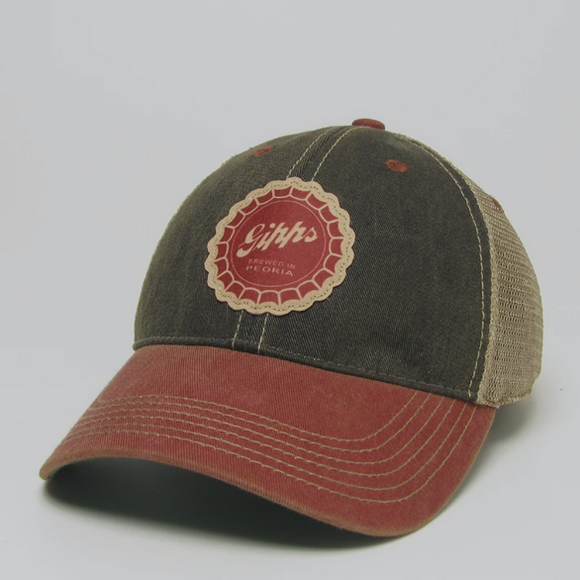Vintage Style Gipps Beer Apparel
History Of Gipps Brewing co.
Even before the Gipps Brewing Company was established in 1881, the Gipps name was prominent in the Peoria brewing community. Below is a historical timeline of the Gipps Brewery and its famous Amberlin Beer that had everyone saying "Give Me Gipps!"
1837
German immigrant and master brewer Andrew Eitel founded a brewery on the banks of the Illinois River at the intersection of Franklin and Washington Streets in Peoria. Eitle chose the site because of its supply of cool artisan well water. The brewery, which cost $78.10 to construct, is one of the first established West of the Allegheny mountains.
1848
England native John Methuen Gipps moves to Tazewell County, Illinois following his immigration to the U.S. in 1845. Upon his arrival, the Cambridge University educated Gipps purchases 160 acres in Morton Township to establish his "Gipps Grove" estate. Gipps becomes the first Grocer in Morton, Illinois.
1864
Gipps purchases Eitel's brewery, establishing the first of many financial partnerships with W.H. Hine and William Howe. Over the next 17 years, Gipps would establish four more partnerships, including the Gipps and Co. "Eagle" brewing company in 1875.
1881
Organized by Gipps, Willis H. Ballance, Sr., and Leslie Robinson, the Gipps Brewing Company is established on the Peoria riverfront at the foot of the Franklin Street Bridge (current Bob Michel bridge.) The new brewery begins producing its famous Amberlin Beer. Gipps serves as President until his passing later that year.
1885
A new, modern brewery is constructed at the foot of E. Franklin and Bridge Streets. George H. Gipps, son of Founder John M. Gipps leaves the Gipps Brewing Company to become Secretary at Peoria's Union Brewing Company. In 1900, George Gipps left Union Brewing Company to take over as Manager of the Terre Haute Brewing Company in Indiana.
1919
The 18th Amendment of the U.S. Constitution is ratified, banning the production and sale of alcoholic beverages. Upon the arrival of prohibition, the Gipps Brewing Company sold its brewery property to the Electrox Company, a manufacturer of oxygen, hydrogen, nitrogen, and acetylene gases.
1933
Following the repeal of Prohibition, the Gipps Brewing Corporation is organized. President Vincent Quinn oversees the rebuilding of the brewery with modern equipment, increasing its capacity to 100,000 barrels per year. Clyde Epperson of Denver, Colorado becomes the majority shareholder.
1934
In October, Gipps Amberlin Beer is brought back to the marketing for first time since the end of Prohibition. To celebrate, Gipps invites local Tavern owners and Bartenders to the brewery for an open house tasting.
1938
Under the care of Brewmaster Edward J. Geisler, the sale of the original all-grain formula of Gipps Amberlin Beer returns to the market for the first time since Prohibition. A new sanitary brewing process is established to ensure product consistency.
1939
Gipps Brewing Corporation establishes Certificates of Approval for dispensing its Amberlin Beer on draft. Approved dealers must adhere to standards of proper temperature, sanitary draft equipment, and clean serving glasses to receive certification.
1941
On July 17, a 44-alarm fire ripped through Warehouse Building No. 9 at on the Southeast corner of the Brewery. A short circuit of an elevator motor caused the fire, causing $70,000 in damage. Building No. 9 stored 40,000 cases of empty bottles. It took over 75 Firefighters, many who were called in off duty, over 2 hours to contain the blaze, which spread through the top four floors of the 6-story building.
1948
Harry J. Krueger takes over as President of Gipps Brewing Corporation following the death of Vincent Quinn.
1951
On March 1, 1951, Peorian Sidney V. Cain becomes President of Gipps, replacing Harry J. Krueger.
1952
Controlling interest in Gipps Brewing Corporation is purchased by Peorians Sidney V. Cain, George Murray, and Harold Mandel, from the Epperson Family of Denver, Colorado.
1953
With a $250,000 investment, the Brewery is again expanded and modernized. Gipps also introduces a new formula for its Amberlin Beer. Packaging is also updated with a full-color foil label for its bottles and a flat-top can.
1954
The Gipps Beer name and formula is sold to Canadian Ace Brewing of Chicago. Manufacturing of Gipps Amberlin Beer is moved to Chicago. Distribution of the beer continues out of the Peoria plant. The new Gipps Distributing Co., announces it will begin manufacturing canned soda pop under the name "Can-A-Pop."
1956
On January 23 the Gipps Distributing Co. ceases operations. With a debt of $581,317, the company files for bankruptcy.
1957
An auction sale is held for Gipps to settle its debts. Continental Can Company of Chicago acquired the business and its debts for $75,000.
1958
Electrical contractors Foster-Jacobs, Inc., acquired the 73-year-old former Gipps Brewery property from Continental Can for $140,000.
1990
The remaining brewery buildings are torn down to make way for the Bob Michel bridge.

 Gipps Beer Vintage Style T-Shirts
Gipps Beer Vintage Style T-Shirts Hats
Hats